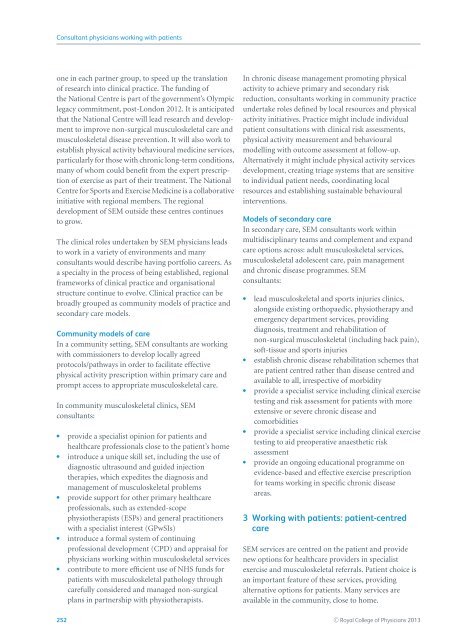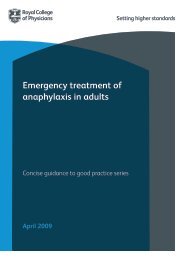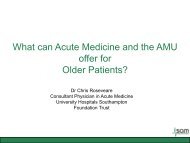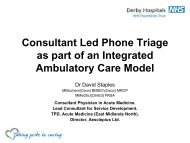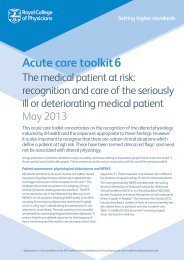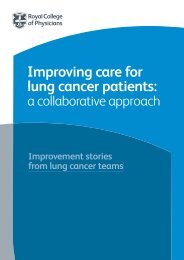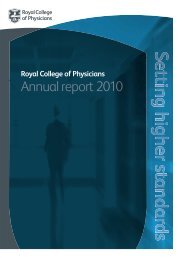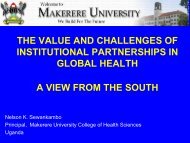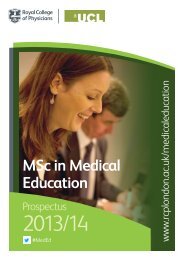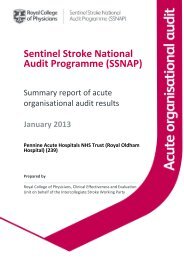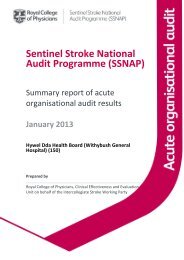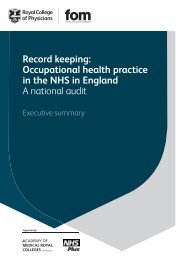Consultant physicians working with patients - Royal College of ...
Consultant physicians working with patients - Royal College of ...
Consultant physicians working with patients - Royal College of ...
Create successful ePaper yourself
Turn your PDF publications into a flip-book with our unique Google optimized e-Paper software.
<strong>Consultant</strong> <strong>physicians</strong> <strong>working</strong> <strong>with</strong> <strong>patients</strong>one in each partner group, to speed up the translation<strong>of</strong> research into clinical practice. The funding <strong>of</strong>the National Centre is part <strong>of</strong> the government’s Olympiclegacy commitment, post-London 2012. It is anticipatedthat the National Centre will lead research and developmentto improve non-surgical musculoskeletal care andmusculoskeletal disease prevention. It will also work toestablish physical activity behavioural medicine services,particularly for those <strong>with</strong> chronic long-term conditions,many <strong>of</strong> whom could benefit from the expert prescription<strong>of</strong> exercise as part <strong>of</strong> their treatment. The NationalCentre for Sports and Exercise Medicine is a collaborativeinitiative <strong>with</strong> regional members. The regionaldevelopment <strong>of</strong> SEM outside these centres continuesto grow.The clinical roles undertaken by SEM <strong>physicians</strong> leadsto work in a variety <strong>of</strong> environments and manyconsultants would describe having portfolio careers. Asa specialty in the process <strong>of</strong> being established, regionalframeworks <strong>of</strong> clinical practice and organisationalstructure continue to evolve. Clinical practice can bebroadly grouped as community models <strong>of</strong> practice andsecondary care models.Community models <strong>of</strong> careIn a community setting, SEM consultants are <strong>working</strong><strong>with</strong> commissioners to develop locally agreedprotocols/pathways in order to facilitate effectivephysical activity prescription <strong>with</strong>in primary care andprompt access to appropriate musculoskeletal care.In community musculoskeletal clinics, SEMconsultants: provide a specialist opinion for <strong>patients</strong> andhealthcare pr<strong>of</strong>essionals close to the patient’s home introduce a unique skill set, including the use <strong>of</strong>diagnostic ultrasound and guided injectiontherapies, which expedites the diagnosis andmanagement <strong>of</strong> musculoskeletal problems provide support for other primary healthcarepr<strong>of</strong>essionals, such as extended-scopephysiotherapists (ESPs) and general practitioners<strong>with</strong> a specialist interest (GPwSIs) introduce a formal system <strong>of</strong> continuingpr<strong>of</strong>essional development (CPD) and appraisal for<strong>physicians</strong> <strong>working</strong> <strong>with</strong>in musculoskeletal services contribute to more efficient use <strong>of</strong> NHS funds for<strong>patients</strong> <strong>with</strong> musculoskeletal pathology throughcarefully considered and managed non-surgicalplans in partnership <strong>with</strong> physiotherapists.In chronic disease management promoting physicalactivity to achieve primary and secondary riskreduction, consultants <strong>working</strong> in community practiceundertake roles defined by local resources and physicalactivity initiatives. Practice might include individualpatient consultations <strong>with</strong> clinical risk assessments,physical activity measurement and behaviouralmodelling <strong>with</strong> outcome assessment at follow-up.Alternatively it might include physical activity servicesdevelopment, creating triage systems that are sensitiveto individual patient needs, coordinating localresources and establishing sustainable behaviouralinterventions.Models <strong>of</strong> secondary careIn secondary care, SEM consultants work <strong>with</strong>inmultidisciplinary teams and complement and expandcare options across: adult musculoskeletal services,musculoskeletal adolescent care, pain managementand chronic disease programmes. SEMconsultants: lead musculoskeletal and sports injuries clinics,alongside existing orthopaedic, physiotherapy andemergency department services, providingdiagnosis, treatment and rehabilitation <strong>of</strong>non-surgical musculoskeletal (including back pain),s<strong>of</strong>t-tissue and sports injuries establish chronic disease rehabilitation schemes thatare patient centred rather than disease centred andavailable to all, irrespective <strong>of</strong> morbidity provide a specialist service including clinical exercisetesting and risk assessment for <strong>patients</strong> <strong>with</strong> moreextensive or severe chronic disease andcomorbidities provide a specialist service including clinical exercisetesting to aid preoperative anaesthetic riskassessment provide an ongoing educational programme onevidence-based and effective exercise prescriptionfor teams <strong>working</strong> in specific chronic diseaseareas.3 Working <strong>with</strong> <strong>patients</strong>: patient-centredcareSEM services are centred on the patient and providenew options for healthcare providers in specialistexercise and musculoskeletal referrals. Patient choice isan important feature <strong>of</strong> these services, providingalternative options for <strong>patients</strong>. Many services areavailable in the community, close to home.252 C○ <strong>Royal</strong> <strong>College</strong> <strong>of</strong> Physicians 2013


